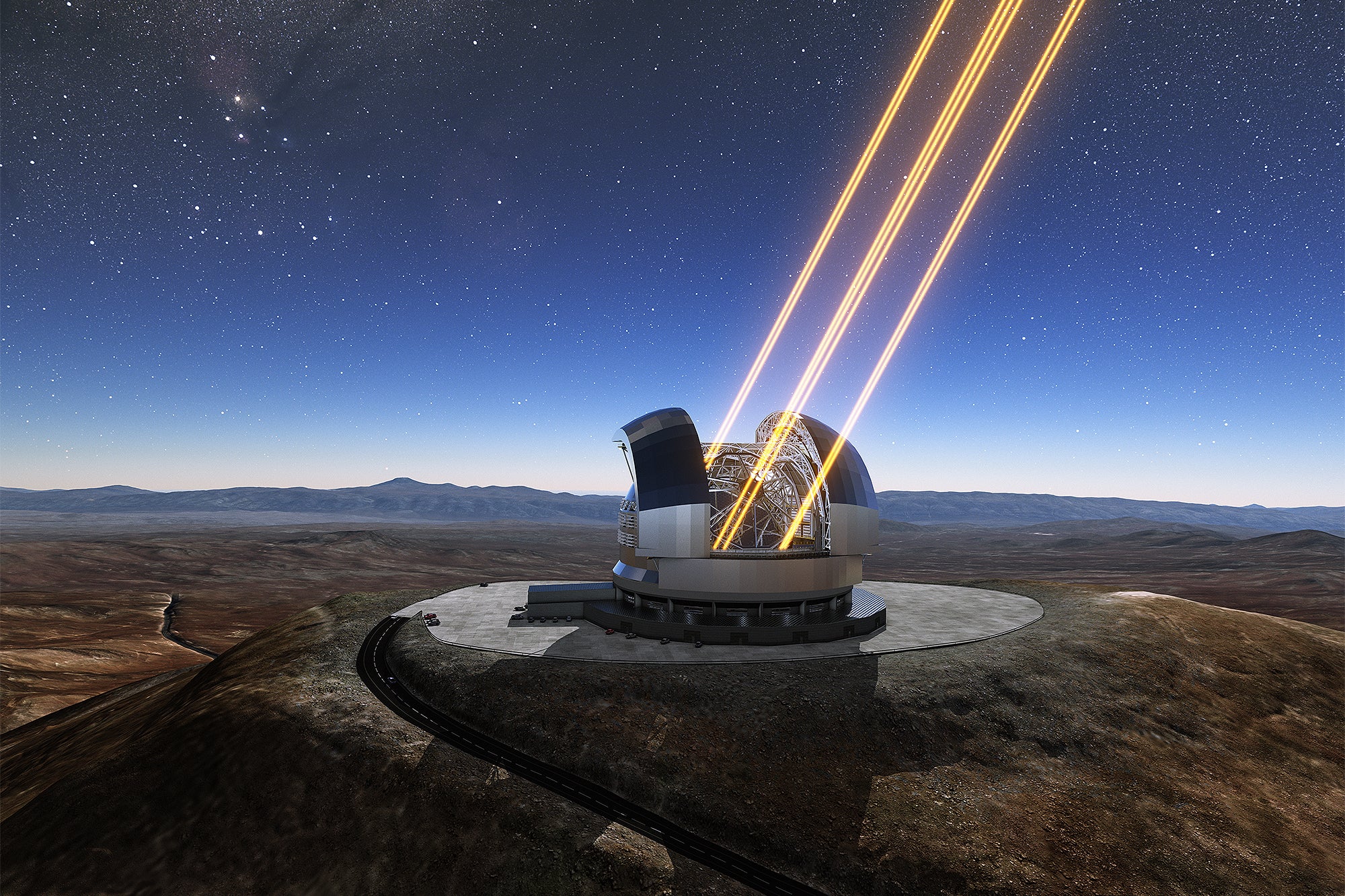
Consider this: Astronomers think of the Hubble Space Telescope as small.
That may surprise you, since after three decades of taking images with depth and detail most ground-based telescopes couldn’t achieve, popular conception holds that Hubble must be one of the biggest telescopes ever built.
But its mirror is only 2.4-meters wide. That’s not terribly large. Even the newer JWST, now taking images evoking gasps similar to Hubble’s, has a mirror that’s 6.5 meters wide, which only puts it in medium-to-big territory among astronomers. Of course, these telescopes were launched to space on rockets, a process that puts its own limits on how hefty a scope can be. On Earth there are telescopes far larger; the Very Large Telescope in Chile has an 8.2-meter mirror, whereas the twin Keck Telescopes in Hawai’i are each a gargantuan 10 meters wide. Several enormous telescopes are currently under construction, including the Giant Magellan Telescope (which has seven 8.4-meter mirrors, adding to an equivalent single mirror 22 meters across) in Chile and the Thirty Meter Telescope in Hawai’i.
And, right now, the beefiest telescope under construction is the European Southern Observatory’s Extremely Large Telescope, or ELT, which, upon completion in 2028, will be a staggering 39 meters across. It will be by far the largest visible and infrared light telescope on—or above—the planet.
ELT may as well be the biggest that will ever be built. The reasons boil down to cost (unsurprisingly), engineering and the implacability of geometric laws.
That last factor will be crucial in limiting the size of jumbo telescopes. Astronomers sometimes call telescopes “light buckets” because they collect light falling from the sky like a bucket in the rain collects water. The bigger the bucket, the more rain you collect. Faint objects drizzle only a very little light that reaches Earth. A bigger telescope collects more light, so in principle it can see fainter objects, more distant galaxies and more ancient stars. After centuries of observations, we’ve seen most of the bright objects in the sky, so the astronomical frontier now is in seeking out those dimmer ones.
Bigger telescopes have another advantage: They have better resolution, the ability to see fine details. A telescope twice as wide can detect details half as large. That means seeing distant galaxies as more than just tiny smudges.
For these reasons astronomers always want larger telescopes. The problem is that past a certain size (roughly 8 meters wide) a monolithic, single-piece telescope mirror is extremely difficult to cast, polish, and use—building a structure just to support such an immense weight is prohibitive. The area of a telescope mirror goes up as the square of the diameter, so a ten-meter telescope will have 4 times the area (and about 4 times the volume, and therefore the weight) of one 5 meters wide.
To overcome this hindrance, astronomers have turned to segmented mirrors; effectively combining several smaller mirrors into one larger one. These are generally hexagonal in shape, because hexagons can be tiled into large arrays easily; JWST uses just such an arrangement. Small motors in the back tip and tilt these segments to ensure they combine as precisely as possible. Even better, these mirrors can be quite thin, and can deform their shape on demand to overcome the blurring induced by Earth’s atmosphere. A boiling mass of gaseous soup, the air distorts and spreads out light coming from the cosmos—this is why stars twinkle. But using highly sophisticated sensors and actuators, the mirror segments deform within milliseconds to correct this turbulence, sharpening the resolution of a telescope. Ground-based telescopes now employ this “adaptive optics” technique routinely to get images as sharp as Hubble’s and JWST’s.
This is how the ELT can be so huge; it will employ 798 individual mirror segments. Each one will be 1.4 meters in width and will have multiple systems to move and change its shape, controlled automatically by sensors and a computer.
The system is understandably expensive; the total baseline cost for ELT is estimated at about $1.5 billion in 2023 dollars. The engineering of this immense beast is cutting edge as well. It requires a vast dome 80 meters high and 88 across, and a foundation equipped with shock absorbers to cushion against vibrations.
This is why the ELT may be one of the largest ground-based telescope, if not the largest, ever built. It’s possible something incrementally bigger could be constructed someday, but anything significantly larger will cost multiple times more, with commensurately larger engineering headaches added. In fact, the ELT started out as an idea called OWL—the OverWhelmingly Large Telescope—that would have been a Brobdingnagian 100 meters wide; after much review a panel of astronomers decided a more modest 39 meters would be sufficient.
Do we need bigger telescopes? ELT was sized to match the scientific needs of the astronomical community. Those included directly imaging nearby exoplanets—including Earth-sized worlds at the right distance from their stars to have liquid water—and seeing back to the era of the universe that birthed the very first galaxies. Bigger telescopes could do more, but at the moment ELT is at the forefront of astronomy. It may lay the groundwork, literally, for future, even larger, telescopes, but their time hasn’t yet come.
And such a future could be delayed further. Astronomers may instead turn to a decades-old technique called interferometry, where observations from radio telescopes large distances apart combine to mimic the resolution of a much larger telescope. The Event Horizon Telescope, which has observed the Milky Way’s central black hole as well as that of the galaxy M87, is a radio interferometer. It combines telescopes across Earth, effectively making an observatory the size of our entire planet.
Sounds great, but there are two problems with interferometry for visible light observations. One is that it doesn’t increase the area of the individual telescopes, so seeing faint sources—a critical aspect of astronomical observations—is still an issue. The other is that the difficulty of combining the observations scales with the frequency of the light detected, where visible light frequencies range far, far higher than radio waves’. Visible-light interferometry has been achieved for telescopes close together—the Very Large Telescope Interferometer uses four 8-meter telescopes a few dozen meters apart, but while longer baselines are possible they’re extremely challenging, requiring nanometer-scale measurement precision. However, if visible-light interferometry is eventually possible with longer baselines, it would ease the need for an even larger telescope than ELT.
Having said that, would astronomers want a larger telescope if it became possible? Yes, obviously. And the cost may yet be less than a far smaller though more nimble space telescope.
And perhaps future technologies will be discovered that can overcome some of the barriers to creating a gigantic visible-light telescope. We might build observatories on the moon, for example, where lower gravity and a lack of atmosphere offer a huge advantage over earthbound instrument settings. A radio telescope a kilometer across, nestled in a lunar crater, has been proposed for the far side of the moon, free from earthly interference, for example. Although radio telescopes are far easier to construct than visible light ones, if we’re positing building such beasts on the moon, perhaps such a behemoth that can detect visible light is something to consider. It’s a dream, but technologies have a way of turning dreams into reality.
Never say never. ELT may be the biggest ever built and may yet hold that record a long, long time. But, perhaps, not forever.
This is an opinion and analysis article, and the views expressed by the author or authors are not necessarily those of Scientific American.



